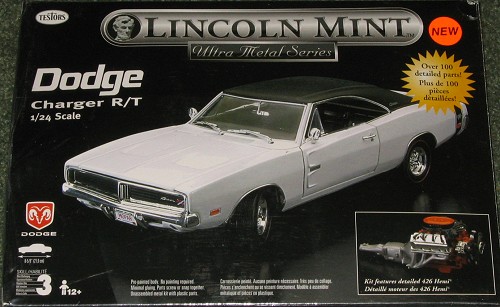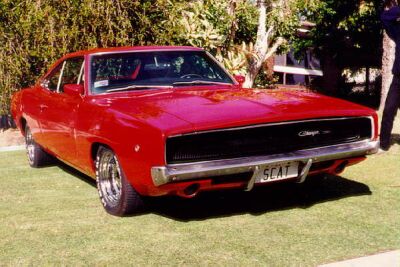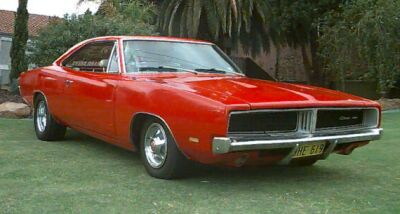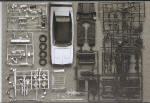
| KIT: | Testors 1/24 Dodge Charger R/T |
| KIT #: | 7141 |
| PRICE: | $30.00 MSRP |
| DECALS: | none |
| REVIEWER: | Scott Van Aken |
| NOTES: | Metal Model Kit |

| HISTORY |
I've decided to concentrate on just this particular body style in the history section. This was the second incarnation of the Charger, the earlier version being a pure fastback and establishing the Charger as Dodge's new musclecar.
1968 Dodge Charger R/T

"Comments: 1968 saw a dramatic redesign of the Dodge Charger with a new
hidden headlight grille, curvy body, recessed backlight, refined tail, and
minimal use of chrome. This redesign resulted in a six-fold increase in
sales from 1967. Out of the 92,590 Chargers produced for 1968, 17,665 had
the R/T package with its standard 440 Magnum engine and "Scat Pack"
bumblebee stripes on the rear end. Only a scant 475 came with the all
mighty Hemi. The Hemi was strengthened for 1968 with a slightly
longer-duration cam, new valve springs, and revisions which reduced oil
consumption. It was still under-rated at 425bhp and still remained the
engine of choice for serious drag racers.
Production: 17,665
Engines: 318 V8 230bhp. 383 V8 335bhp. 426 V8 Hemi 425bhp@5000rpm,
490lb-ft@4000rpm. 440 V8 375bhp@4600rpm, 480lb-ft@3200rpm.
Performance: 426 Hemi V8 425: 0-60 in 5.3 sec, 1/4 mile in 13.8 sec @
105mph.
1969 Dodge Charger R/T

Comments: 1969 saw little change for the regular Dodge Charger. Instead,
Dodge released two special versions of the Charger, in order to better
compete in NASCAR. The first was the Charger 500, which was basically a
1968 Charger with improved aerodynamics. The Charger 500 had a flush
mounted Coronet grille with a flush mounted rear window over the recessed
backlight. Although the Charger 500 had some racing success, Dodge
engineers felt they could do more. They went back to the wind tunnel and
came back with the Dodge Charger Daytona, the most outrageous musclecar of
the era. In front, the Daytona sported a pointed 18 inch nose extension
which reduced drag and enhanced downforce. Out back, the Daytona retained
the 500's recessed backlight but added a horizontal tail stabilizer on tall
vertical extensions (known as a "wing" in today's lingo). The wing had to
be tall enough on prodcution versions in order to open the trunk and some
dealers had to remove them in order to sell the cars. Priced at $4,000, the
Daytonas were available with either the 440 or the 426 Hemi and 503
examples were eventually sold. Weighing almost 300 pounds more than regular
Chargers with the same engines, the Daytona's were hampered on the street.
But they could top out at over 150 mph on the track -- and it was
completely street legal. This was truly the height of the performance
mania.
Production: 20,057
Engines: 318 V8 230bhp. 383 V8 335bhp. 426 V8 Hemi 425bhp@5000rpm,
490lb-ft@4000rpm. 440 V8 375bhp@4600rpm, 480lb-ft@3200rpm.
Performance:
1970 Dodge Charger

Comments:
1970 saw another redesign of the Dodge Charger which now had a new chrome
loop front bumper and a fresh full width taillamp housing. R/T versions
gained a simulated reverse body scoop. Hip, young colors such as Plum Crazy
and Go-Mango became available and a cool pistol-grip handle now topped the
available four-speed shifter. Also available was the extra cost SE version
with its leather upholstery and for the first time there was an available
electric sliding sunroof. Performance buffs cheered at the addition of a
new engine choice, the 440 Six Pack. Slotted between the 440 Magnum and the
Hemi, the 440 Six Pack traded in the 440's 4 barrel carburetor for 3 Holley
two barrels, increasing the horsepower from 375 bhp to 390 bhp. The Hemi
was also improved, with the addition of hydraulic lifters, instead of solid
tappets. Still, rising insurance costs took their toll and only 10,337 R/Ts
were sold in 1970. Of these a mere 116 were 440 Six Packs and only 42 were
Hemis.
Production: 10,337
Engines: 318 V8 230bhp. 383 V8 335bhp. 426 V8 Hemi 425bhp@5000rpm,
490lb-ft@4000rpm. 440 V8 375bhp@4600rpm, 480lb-ft@3200rpm. 440 Six Pack V8
390bhp@4700rpm, 490lb-ft@3200rpm
Performance: 426 Hemi V8 425: 0-60 in 5.5 sec, 1/4 mile in 13.9 sec @
105mph."
Thanks to http://www.musclecarclub.com for the background information.
| THE KIT |
 This kit is the 1969 version of the
Charger and in particular the Charger R/T version with the 425 hp 426 cubic
inch (7 liter) hemi. The packaging is excellent with most sprues being one
to a bag, this being quite important with the chrome bits to prevent
scratches. A number of the pieces on the
This kit is the 1969 version of the
Charger and in particular the Charger R/T version with the 425 hp 426 cubic
inch (7 liter) hemi. The packaging is excellent with most sprues being one
to a bag, this being quite important with the chrome bits to prevent
scratches. A number of the pieces on the
![]() 'standard'
sprues are pre-painted which will definitely help to speed up the assembly
of the kit. This isn't shown in the parts layout as I scanned this from the
side of the box, but here are a couple of close-ups to show a few examples.
One is the grille where you can see tha
'standard'
sprues are pre-painted which will definitely help to speed up the assembly
of the kit. This isn't shown in the parts layout as I scanned this from the
side of the box, but here are a couple of close-ups to show a few examples.
One is the grille where you can see tha![]() t
they've blacked out the majority of the grille and added the red paint to
the 'R/T' logo. The other is the engine block where the block is painted
red (as are many of the other engine block parts) and the transmission is
in an aluminum finish. It would be up to the modeler to decide on how to
treat those areas of the pre-painted or chrome parts that are attached to
the sprues.
t
they've blacked out the majority of the grille and added the red paint to
the 'R/T' logo. The other is the engine block where the block is painted
red (as are many of the other engine block parts) and the transmission is
in an aluminum finish. It would be up to the modeler to decide on how to
treat those areas of the pre-painted or chrome parts that are attached to
the sprues.
The kit comes with a pre-painted metal body that has been superbly painted. Also included are vinyl tires that have also been pre-painted with the appropriate red lines around them. One thing I should say as a bit of tongue in cheek warning is that once you start to take the parts out of the box, you should begin building as there is no way you'll get everything properly back in place!
While I'm sure that the finished model will look super with no touch-up at all, there are many of us who would prefer to get as clean a join as possible. In this light, the construction of the kit will have to be adjusted. A number of parts are actually screwed together instead of glued (as you can see by the hole drilled in the side of the engine block image). However, for the most part, glue will be needed in assembly.
This is not a curb-side but a kit with opening doors, hood, and trunk. There are panels for the insides of the doors and a trunk compartment is included. In addition, the front wheels are designed to turn.
Instructions are quite complete, providing information on what parts are to be cemented, screwed, or left as is. Painting information is also supplied throughout the construction sequence, with basically silver, black and red being the colors used on this kit. There are also annotations on what parts of the kit are to be dry-brushed or to have washes applied. The instructions provide short introductions to these detailing methods; a most helpful addition to the overall building process. There are decals for the license plates and dash instruments. Also included is a photo etched 'Charger' name plate to go on the sides of the 'vinyl' roof section, but this is an optional piece. The glue recommended is "Testors cement for metal and wood models". I can only assume this to be some sort of super glue or perhaps a contact cement. I've not used this before. Many of us will use standard styrene cement for the plastic bits, removing the plating where needed, and super glue for those bits that attach to metal.
| CONCLUSIONS |
I have to say that this looks to be one very impressive car kit. It isn't exactly a slammer as there are a lot of parts involved, but it does take care of a lot of the painting that one normally does. For those of us who generally shy away from car models and for those who want a very nice quality display model without much of the usual work involved in a standard car kit, this one should fill the bill quite nicely.
| REFERENCES |
November 2005
Thanks to
 for the review kit. You can find Italeri kits at your favorite hobby shop
or on-line at
www.testors.com
for the review kit. You can find Italeri kits at your favorite hobby shop
or on-line at
www.testors.com
If you would like your product reviewed fairly and quickly by a site that has nearly 300,000 visitors a month, please contact me or see other details in the Note to Contributors.